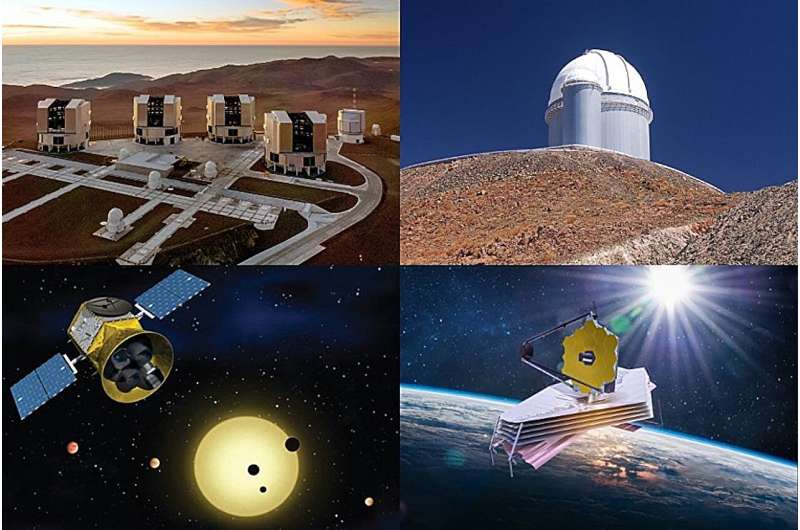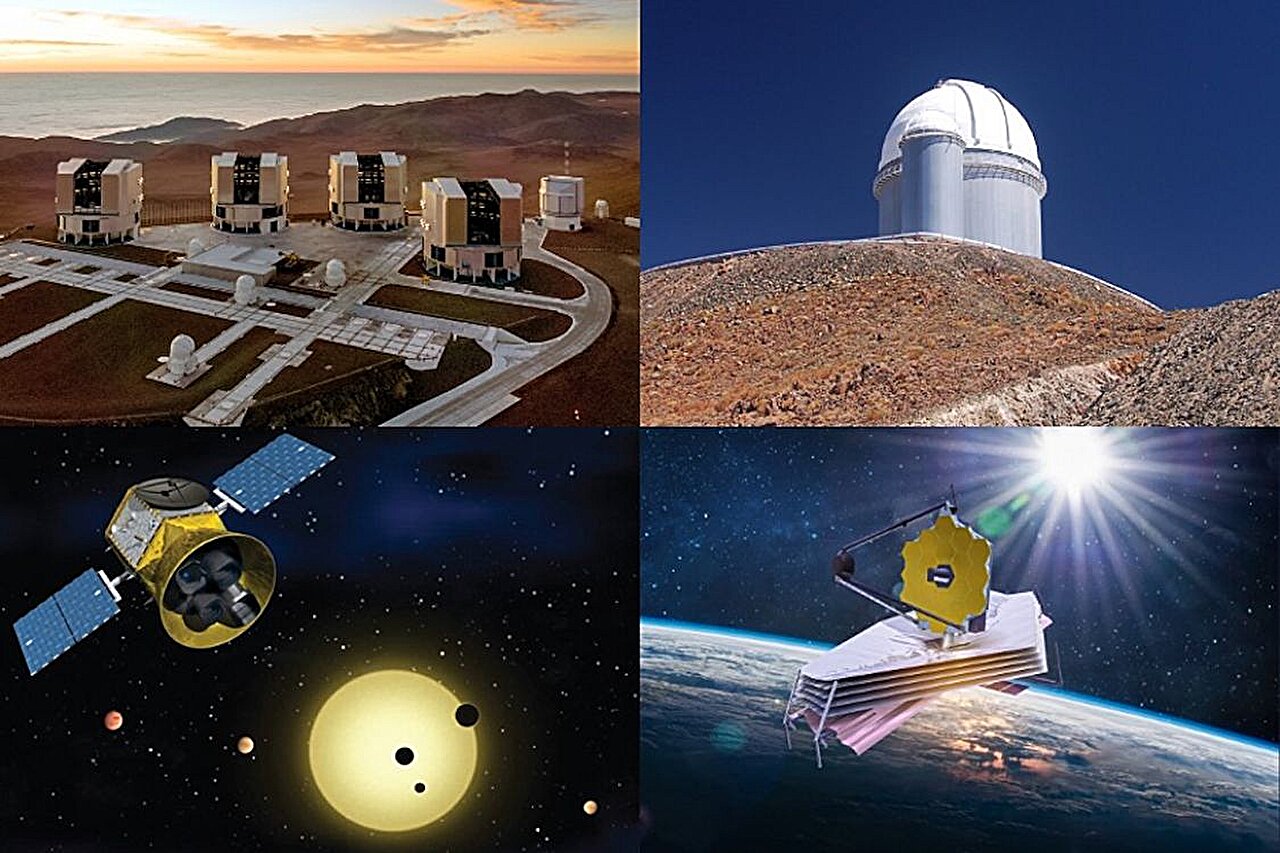
This study exploits data from two ground-based telescopes: the Very Large Telescope (top left, credit: ESO/G. Hüdepohl) and the ESO 3.6-metre telescope, with the HARPS instrument (top right, credit: ESO), as well as two space telescopes: TESS and JWST, shown here in artistic representations, respectively, bottom right and bottom left. Credit: NASA
A team led by UdeM researchers confirms a fifth potentially habitable planet around L 98-59, a red dwarf 35 light-years away.
A team led by the Trottier Institute for Research on Exoplanets (IREx) at the Université de Montréal has achieved the most precise study to date of the L 98-59 planetary system, and confirmed the existence of a fifth planet in the star’s habitable zone, where conditions could allow liquid water to exist.
The article “Detailed Architecture of the L 98-59 System and Confirmation of a Fifth Planet in the Habitable Zone” has been accepted for publication in The Astronomical Journal. It is currently available on the arXiv preprint server.
Volcanic planets, a sub-Earth, and a water world
L 98-59, a small red dwarf located just 35 light-years from Earth, hosts three small transiting exoplanets discovered in 2019, thanks to NASA’s TESS space telescope, and a fourth planet revealed through radial velocity measurements with the European Southern Observatory’s ESPRESSO spectrograph. All four planets orbit their parent star in a compact orbital configuration, all at distances five times closer than Mercury is to the sun.
By carefully reanalyzing a rich set of observations from ground-based and space-based telescopes, a team led by Université de Montréal and Trottier Institute for Research on Exoplanets (IREx) researcher Charles Cadieux has determined the planets’ sizes and masses with unprecedented precision.
“These new results paint the most complete picture we’ve ever had of the fascinating L 98-59 system,” said Cadieux. “It’s a powerful demonstration of what we can achieve by combining data from space telescopes and high-precision instruments on Earth, and it gives us key targets for future atmospheric studies with the James Webb Space Telescope.”
All planets in the system have masses and sizes compatible with the terrestrial regime. The innermost planet, L 98-59 b, is only 84% of Earth’s size and about half its mass, making it one of the rare sub-Earths known with well-measured parameters.
The two inner planets may experience extreme volcanic activity due to tidal heating, similar to Jupiter’s volcanic moon, Io, in the solar system. Meanwhile, the third, unusually low in density, may be a “water world,” a planet enriched in water unlike anything in our solar system.
The refined measurements reveal nearly perfectly circular orbits for the inner planets, a favorable configuration for future atmospheric detections.
“With its diversity of rocky worlds and range of planetary compositions, L 98-59 offers a unique laboratory to address some of the field’s most pressing questions: What are super-Earths and sub-Neptunes made of? Do planets form differently around small stars? Can rocky planets around red dwarfs retain atmospheres over time?” adds René Doyon, co-author of the study, who is a professor at UdeM and the Director of IREx.
Discover the latest in science, tech, and space with over 100,000 subscribers who rely on Phys.org for daily insights.
Sign up for our free newsletter and get updates on breakthroughs,
innovations, and research that matter—daily or weekly.
A fifth planet in the habitable zone
One of the key breakthroughs of this study is the confirmation of a fifth planet in the L 98-59 system. This planet, designated L 98-59 f, does not transit its host star—meaning it doesn’t pass directly between us and the star—but its presence was revealed through subtle variations in the star’s motion, detected using radial velocity measurements from HARPS (High Accuracy Radial velocity Planet Searcher) and ESPRESSO data.
L 98-59 f receives about the same amount of stellar energy as Earth does from the sun, placing it firmly within the temperate, or habitable zone, a region where water could remain in liquid form.
“Finding a temperate planet in such a compact system makes this discovery particularly exciting,” said Cadieux. “It highlights the remarkable diversity of exoplanetary systems and strengthens the case for studying potentially habitable worlds around low-mass stars.”
Unlocking new insights with existing observations
Rather than requesting new telescope time, the team made these discoveries by relying on a rich archive of data from NASA’s TESS space telescope, ESO’s HARPS and ESPRESSO spectrographs in Chile, and the JWST.
They employed the novel line-by-line radial velocity analysis technique introduced by IREx researchers in 2022 to improve the precision of the data significantly. By combining it with a new differential temperature indicator also developed by the team, they were able to precisely identify and remove the stellar activity signal from the data, revealing the planetary signal in unprecedented detail.
By combining these enhanced measurements with analysis of transits seen by JWST, the team doubled the precision of mass and radius estimates for the known planets.
“We developed these techniques to unlock this kind of hidden potential in archival data,” adds Étienne Artigau, co-author of the study and researcher at UdeM. “It also highlights how improving analysis tools allow us to improve upon previous discoveries with data that is just waiting to be revisited.”
Next stop: Webb
These results confirm L 98-59 as one of the most compelling nearby systems for exploring the diversity of rocky planets, and, eventually, searching for signs of life.
Its proximity, the small size of its star, and the range of planetary compositions and orbits make it an ideal candidate for atmospheric follow-up with the JWST, which the IREx team has already started.
“With these new results, L 98-59 joins the select group of nearby, compact planetary systems that we hope to understand in greater detail over the coming years,” says Alexandrine L’Heureux, co-author of the study and Ph.D. student at UdeM. “It’s exciting to see it stand alongside systems like TRAPPIST-1 in our quest to unlock the nature and formation of small planets orbiting red dwarf stars.”
More information:
Charles Cadieux et al, Detailed Architecture of the L 98-59 System and Confirmation of a Fifth Planet in the Habitable Zone, arXiv (2025). DOI: 10.48550/arxiv.2507.09343
Provided by
University of Montreal
Citation:
Team confirms a fifth potentially habitable planet around L 98-59, a red dwarf 35 light-years away (2025, July 22)
retrieved 22 July 2025
from https://phys.org/news/2025-07-team-potentially-habitable-planet-red.html
This document is subject to copyright. Apart from any fair dealing for the purpose of private study or research, no
part may be reproduced without the written permission. The content is provided for information purposes only.

